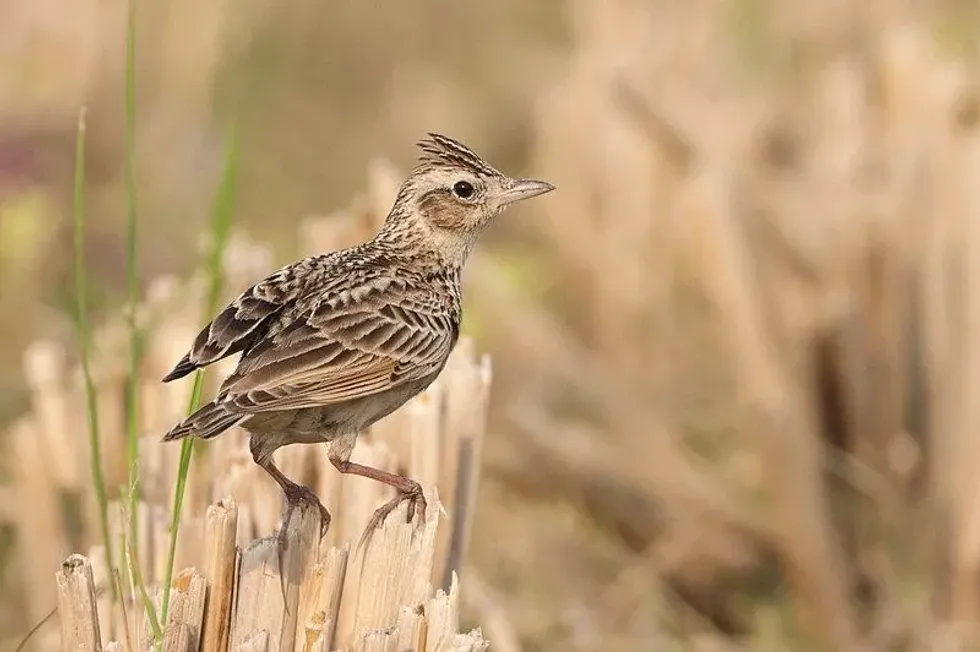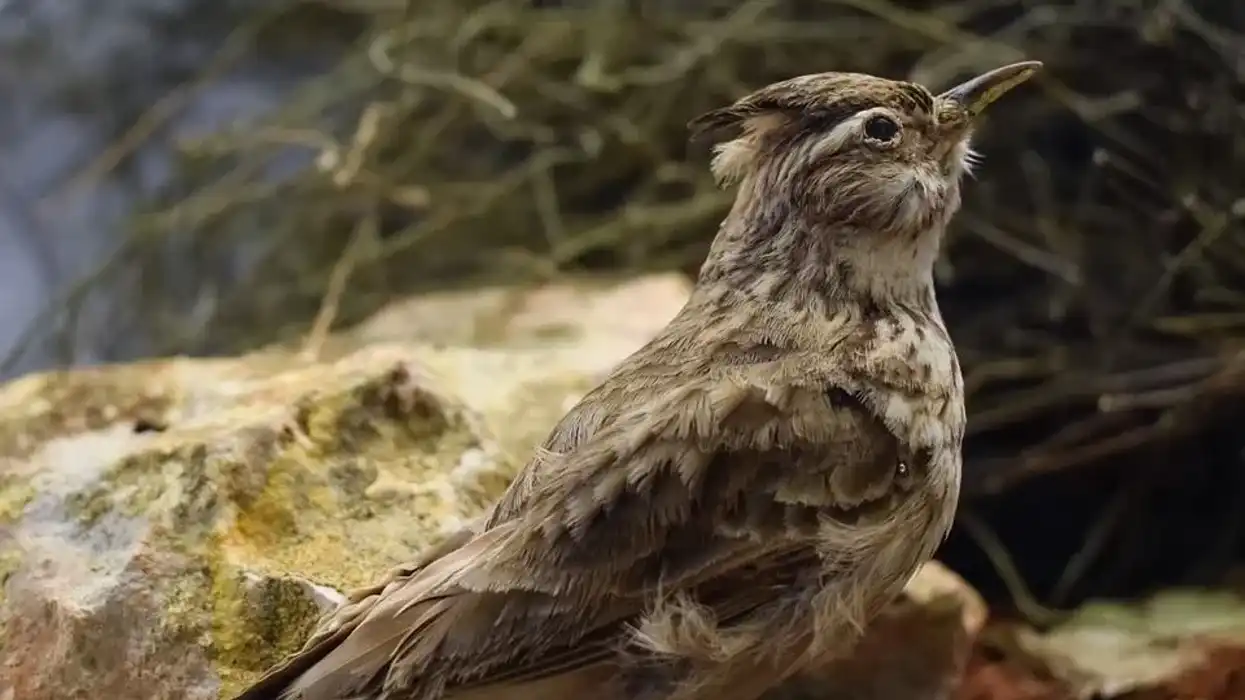The skylark (Alauda arvensis) is a songbird, from the order Passeriformes, sub-order Passeri, and the Alaudidae family which was introduced in 1758 by Carolus Linnaeus was a Swedish botanist, physician, and zoologist. The family consists of over 80 species, which are further divided into 21 genera.
This article will tell you everything you need to know about a very special skylark including its systematics, description and identification, distribution, range, behavior, feeding, breeding, and singing habits!
The oriental skylark commonly known as the brown small skylark is a species of skylark birds belonging to the Alaudidae family, the order Passeriformes, and is the genus of Alauda.
Alauda was originally believed to be of Celtic origin, but was later confirmed as Latin meaning 'of the field'.
They were originally named by an English naturalist- James Franklin (1831).
The epithet gulgula has no definite meaning but some people think its name is the result of various references made to the bird's song as gula is the Latin word for throat, or perhaps because the color of the bird being identical to a popular donut-type dessert from India known as gulgula itself!
There are about 13 subspecies of this bird, including the Kashmir skylark, and the Western oriental skylark or Turkestan small skylark.
The oriental skylark (Alauda gulgula, 1831) also known as the Indian skylark, Eastern skylark, and lesser skylark distribution occurs in southern, central, and eastern Palearctic, basically throughout Asia, including countries like China, India, and eastern Thailand, and just like every other skylark species they live in open grasslands with tall crops, and plenty of natural vegetation.
Learn about some other birds from our swallow-tailed kite facts and blue jay facts pages.
Oriental Skylark Interesting Facts
What type of animal is an oriental skylark?
An oriental skylark (Alauda gulgula) is a bird belonging to the Animalia kingdom.
What class of animal does an oriental skylark belong to?
An oriental skylark (Alauda gulgula) belongs to the Aves class, the family Alaudidae, the order Passeriformes, and is the genus of Alauda.
How many oriental skylarks are there in the world?
The accurate population size of the species is unknown. However, these birds and the subspecies are found in plenty across southern-east Asia.
Where does an oriental skylark live?
The oriental skylark range occupies western Afghanistan, Eastern Bangladesh, north of Bhutan, Cambodia, South-eastern China, eastern Thailand. They are also found across north, central, and south India and Iran.
What is an oriental skylark's habitat?
The oriental lark nests are found in open grasslands, wetlands, agricultural fields, extensive croplands, marshes, or meadows. They have excellent adaptability to various climatic conditions and can survive in humid as well as colder climates, but prefer living in temperate regions.
Who do oriental skylarks live with?
They prefer being alone but are often found in pairs a short while before the breeding season begins. Some even join large flocks that include their subspecies during the winter perhaps to help each other stay warm and to provide sufficient food for the young chicks.
How long does an oriental skylark live?
An oriental lark lives up to two or six years.
How do they reproduce?
An oriental skylark (Alauda gulgula) found in South-eastern Asia is seasonally monogamous, which means they mate with only one bird per breeding season.
An oriental skylark male before the breeding season begins tries to impress a female by its renowned singing behavior, starting in the early dawn hours until sunset, they even chase a female at high speeds in the sky to display a readiness to mate. The breeding season begins in late March and lasts up to July or August.
The oriental lark unlike the majority of the birds is a ground-nesting bird and builds its nest in tufts of tall grass on the ground rather than in the crooks, cavity, or on a branch of a tree.
This species is highly territorial and displays aggression towards invaders by fluttering off the ground with their wings half-spread, or by ruffled feathers, a raised crown, aerial combats, a series of aggressive, rough, and confused fluttering. A short while before mating the female birds build their nests with little help from males.
The nests are built into or on the ground in the form of a shallow depression and are lined with leaves, grass, stems, and other finer materials.
An oriental skylark female lays about three to five eggs in a single clutch.
These eggs are pale gray, or off-white, and covered with brown speckles. Incubation lasts for 11-14 days, the nest is protected by both parents.
The young hatchlings have a faded plumage, and a weak crest, they leave the nest several days or a week after they hatch.
Foxes and snakes often prey on young hatchlings.
What is their conservation status?
The IUCN Red List of Threatened Species has classified oriental lark (Alauda gulgula) as species of Least Concern. However, they may be rare in certain countries due to grass being too short for laying eggs.
Oriental Skylark Fun Facts
What do oriental skylarks look like?
This species is quite difficult to separate from other larks, however, an oriental skylark (Alauda gulgula) has a streaked, yellow-brown plumage, and white outer tail feathers, and a weak crest, white belly. Their coloration does not differ much from other species of larks. Similar physical features are found in both sexes.
However, males are slightly larger, with longer wings, bills, and tails compared to females. While flying, their tail, feathers, and wings appear rather short and rounded.
The extended edges of their wings are pale yellowish-red or rust-colored. Both adult and juvenile oriental skylarks have a complete molt from early August to mid-October. A juvenile lark has a duller plumage and a shorter outer tail.
How cute are they?
These birds are considered cute because of their small size, white outer tail feather, weak crest, and simple yet striking patterns!
How do they communicate?
Larks primarily communicate with a song or calls. The males of this species are more vocal than females, and often hover in the air while singing to attract them.
They have a beautiful voice and their song is even better! It is sweet and pleasant to hear. Their communication includes singing, calls, squeaks, squawks, gurgles, warbles, trills, rattles, clicks, croaks, whistles, and howls.
The best way to separate them from other birds is by carefully listening to their song
How big is an oriental skylark?
An oriental lark grows up to 6.3 in (16 cm) in size. A swan goose is nearly six times bigger than an oriental lark.
How fast can an oriental skylark fly?
These birds have a poor speed rate at low elevations, as it tends to hover and flutter its wings. This is considered odd by many people given that small-sized birds are known to fly swiftly and fast.
However, at a higher altitude, these birds have a better flight action. While flying or during take-off, these birds look similar to the woodlark.
How much does an oriental skylark weigh?
An oriental lark weighs about 0.8-1 oz (24-30 g).
What are the male and female names of the species?
This species does not have sex-specific names for its members. They are simply denoted as males and females.
What would you call a baby oriental skylark?
A baby oriental skylark is called an oriental skylark hatchling or a chick.
What do they eat?
Just like other skylarks, birds of this species are omnivores and can be found foraging in open grassland, a field, and a meadow, where it feeds on seeds, beetles, earthworms, and flies.
Many animals such as snakes, coyotes, wild or domestic cats, predatory birds like eagles, falcons, and owls prey on them and destroy their nests.
Are they poisonous?
No, these birds are not poisonous.
Would they make a good pet?
No, these birds are wild and like living in open and free spaces and would not make good pets. They are best left with their kind, in their natural habitat.
Did you know...
Birds of this species are found in medium to large-sized flocks during severe weather conditions. Flocks often do not consist of more than 8-12 individuals. If they do, they often break apart into smaller flocks to make improve their chances of surviving.
The oriental lark was originally described as a separate species.
They are advantageous to farmers as they consume the seeds of weeds and eat pests such as caterpillars that cause damage to the crops in a field. The shape of their bill is adapted to their diet and feeding techniques.
A skylark's (Alauda arvensis) song has inspired many renowned poets.
The other scientific name of the species is Alauda gulgula herberti, also given by James Franklin (1831).
What are skylarks known for?
They are renowned for their aerobatic displays while in flight, and their beautiful song.
Are oriental skylarks endangered?
Earlier humans used to hunt and capture these birds, to sell them as pets. This greatly reduced their numbers. However, their population size recovered from it and is stable at the moment!
Here at Kidadl, we have carefully created lots of interesting family-friendly animal facts for everyone to discover! Learn more about some other birds from our whiskered treeswift facts and American pipit facts pages.
You can even occupy yourself at home by coloring in one of our free printable oriental skylark coloring pages.










